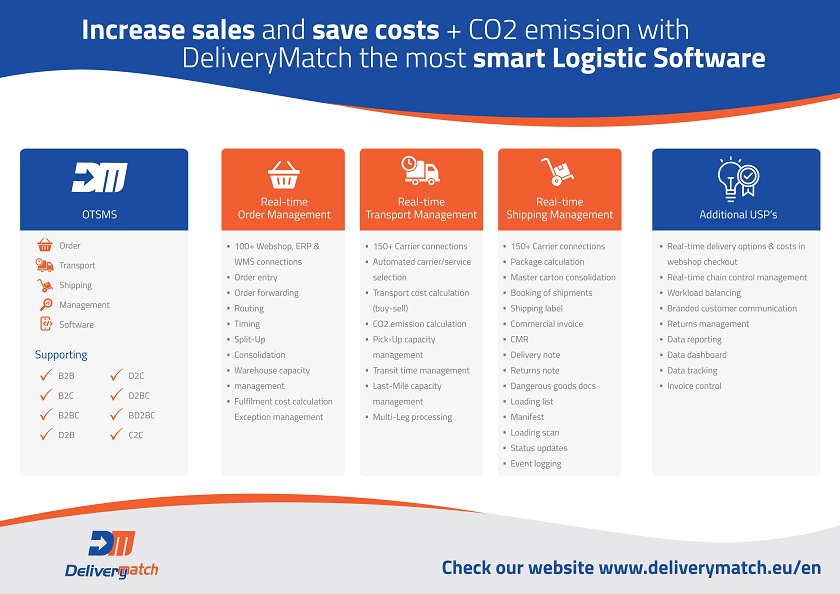
e-Commerce Logistics in Europe: Integrate or Stagnate

Introduction:
The e-commerce market in all European countries is growing rapidly and becoming more diverse. Also, more and more combinations of B2C and B2C sales need to be integrated in the logistic chains. This implicates logistic chains becoming more complex every day.
Operational effects:
Operations will always be sales driven. This implies that Logistic concepts- and operations always need to follow the sales concept and need to relate to them. The following sales trends have their impact on the Logistic concepts- and operations:
- More and more companies combine B2C and B2B sales.
- More and more companies combine online and offline retail. This started with companies that where offline retailers from origin and added online retail during time, some successful, many not successful. Since a few years also from origin online retailers added offline sales channels. Since in general this is a very capital-intensive strategy this trend is only in a start phase currently.
- More and more companies use D2C and D2B, so they let their providers ship the (partial) purchase directly to their customers.
- More and more companies sell cross-border, within Europe or Worldwide.
- More and more companies sell, beside their own sales channels, via wholesales platforms like Amazon, Ebay, Zalando, Britdeals, Chinabrands, OTTO, Etsy, CDiscount, Darty, Bol.com and Wehkamp.
- More and more manufacturers also sell directly to consumers.
- More and more companies have a wide product range and large ‘long tail’.
- More and more companies sell products with a wide range of physical characteristics (weight, dimensions, breakable, dangerous goods, fresh goods, etc. etc.).
- While in B2B business often companies are working with SLA’s and the requested performance of logistic operations is (more or less) known upfront and thus (more or less) predictable, the online consumer (B2C) expects his/her own specific temporary ‘SLA’ for each purchase they do online.
- So Multichannel and Omnichannel sales concepts are becoming more and more common.
At the same time quite some important GAPs occur between what retailers offer regarding logistics services and what consumers actually want. Closing these GAPs can be a challenge, but at the same time they bring opportunities to increase sales and decrease logistic costs and CO2 emission. See the graph with an overview of the GAPs below.

Recommendations
In order to close the GAPs the following challenges occur from a logistics point of view:
- Stock needs to be available for multiple sales channels and/or companies in different countries. This implies that stock is in different warehouses, maybe at different companies and in different countries. Extracting real-time and reliable stock availability, shipping capacity/options, pick-up capacity/options and delivery capacity/options of the various warehouses and carriers at the transaction moment is a must, but very complex. It requires OTSMS functionality that is real-time integrated with the Webshop front-end(s), WMS and ERP systems and the carrier systems in the chain.
- There often is a wide range of physical characteristics of products (weight, dimension, fragile, dangerous, etc.) being sold online. This implies that multiple carriers with a variety of services are needed to be able to deliver the orders to the customers.
- Both offline stores as online consumers need to be delivered, many companies struggle with the question how to integrate offline and online distribution in warehouses and transport.
- Both B2C as B2B sales need to be serviced with logistic solutions, many companies struggle with the question how to integrate B2C and B2B distribution in warehouses and transport.
- Selling cross-border brings challenges regarding stock location, customs requirements, multiple carriers needed and transport costs that can vary greatly per order.
- And when companies start to combine their sales offline, online, B2C, B2B, via Wholesale platforms and cross-border al previous mentioned Logistic challenges are instant reality.
- When using D2C and/or D2B dropship solutions to ship a (partial) purchase directly from the supplier towards the customer even more systems in the chain must be connected and the data for stock availability and logistic capacity of their warehouse(s) and carrier(s) must be available real-time during the purchase process to:
- Be able to offer reliable shipping options and costs.
- Be able to optimize the chain.
- On top of that the demands on the level of Logistic service excellence are more and more increasing, so failure and limited service have a direct negative impact on the revenue because of decreasing conversion and retention.
Solutions
These trends and the Logistic challenges that come with them stress the need for a seamless real-time flow of products and information from ‘checkout to doorbell’ because ‘the Last Mile starts with the first click’. Throughout the Logistic chain, the involved retailers, manufacturers, warehouses and carriers need to be closely and real-time linked/integrated to assure reliable ‘first time right’ shipping- and delivery also providing the customer options regarding Logistic services. At the same time reducing CO2 emission is becoming more and more important, but the good news is that doing the things ‘first time right’ and offering the consumer reliable shipping- and delivery options will help not only to increase sales and reduces costs, but also will help to reduce CO2 emission. Multi-Store, Multi-Warehouse and Multi-Carrier solutions must be in place for this. Let your logistic chains work for you as a ‘sales engine and costs saver’.
An important advice we can give based on this research and our conceptional and operational knowledge and experience, is to include logistic conceptional and operational expertise from scratch when designing a new sales channel and not afterwards.
To make all this possible real-time integration of the logistic chain ‘from checkout to doorbell’ is a must! A solid OTSMS can help to make integration of the logistics chain much easier and can help to manage the operational execution within the logistic chain. The OTSMS platform must have the functionality for Order, Transport and Shipping Management in one. This to enable having one single and fast point to manage the flow real-time. If you would split it up, you would encounter quite some issues regarding the speed of processing and sharing data and data differences within the logistics chain.
You could compare the OTSMS with a ‘traffic controller’.

Integrate or stagnate!
Want to learn more? Check the source details below or contact DeliveryMatch.
Source:
- e-Commerce Logistics in Europe: Integrate or Stagnate
- Author: Dr. Roland Slegers-Leijsten EMIM, CEO DeliveryMatch BV
- Available via Amazon
- Available via Bol.com
DeliveryMatch:
Quelle: https://www.deliverymatch.eu
Schlagwörter: DeliverysMatch










